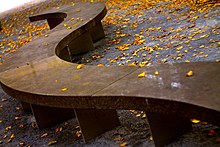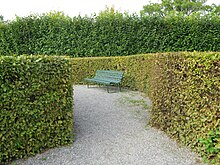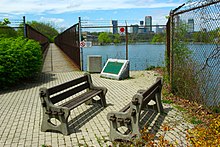This article has multiple issues. Please help improve it or discuss these issues on the talk page. (Learn how and when to remove these messages)
|

A bench is a long seat on which multiple people may sit at the same time. Benches are typically made of wood, but may also be made of metal, stone, or synthetic materials. Many benches have back rests, while others do not and can be accessed from either side. Arm rests are another common feature. In many American public areas, benches may be donated by persons or associations, as indicated by an affixed plaque, a common form of memorial to a deceased person (see memorial bench). Benches may be placed outdoors or indoors, but are more often found outdoors.

Types



Often, benches are simply named for the place they are used, regardless of whether this implies a specific design.
- Park benches are set as seating places within public parks, and vary in the number of people they can seat.
- Garden benches are similar to public park benches, but are longer and offer more sitting places.
- Picnic tables, or catering buffet tables, have benches as well as a table. These tables may have table legs which are collapsible, in order to expedite transport and storage.
- Scenic benches are situated to provide a more comfortable means of enjoying the contemplation of a beautiful landscape, a busy street scene, or less commonly a specific event.
- Perch benches are usually situated in high traffic areas to enable people to take a quick break.
- A storage bench is a combination of sitting space and a storage box, often used for keeping gardening supplies or grill equipment.
- A form is a backless bench that was used for seating in dining rooms, school rooms and law courts — can be leather or upholstered fabric with or without a back rest.
- Wooden benches in early railway passenger cars


Various types of benches are specifically designed for and/or named after specific uses, such as:
- Leaning benches, or "leaners", have been installed by some cities for people to rest against in public areas where there is no room for regular benches.
- Church benches and pews inside places of worship, which are sometimes equipped with an additional kneeling bench. Church benches and pews can come in various styles including traditional, modern and curved to match and complement the architectural styles and spaces of places of worship.
- a bench seat is a traditional seat installed in automobiles, featuring a continuous pad running the full width of the cabin.
- a bench (weight training) is used for fitness exercises, such as the bench press which is named after its use of a bench
- a communion bench is not used as a seat
- a piano bench usually offers one person seating, but there are also two-person variants allowing for pair-playing
- swing seats are independently movable, suspended benches, used for play or as a relaxing porch swing.
- Glider Benches are similar to Swing Seats but are not suspended; instead they have a mechanism under the seating area that allows the bench to rock back and forward
- a courting bench (or kissing bench, or tête-à-tête): a two-seater with the seats pointing in opposite directions, thus almost facing each other.
- a buddy bench (or friendship bench) in a school playground is where a child can go when they want someone to talk to.
- the bench in a courtroom, behind which the judge is seated.
Construction materials
Benches come in a variety of different materials, but there are some venue standards that account for use, durability, and maintenance patterns.
- Adobe: (banco) type benches are made of packed earth often combined with a binder, such as straw. They are found throughout the world in countries that use earth or mud construction techniques, in both outdoor and indoor settings.
- Aluminum: Aluminum benches are often found in outdoor, sideline settings at recreational venues like sports fields or courts and as a complement to bleacher systems. The material affords for a lightweight, corrosive-free bench, so it is a portable and economical option for indoor or outdoor settings.
- Cast iron: early outdoor benches were made of cast iron, Among the earliest in America were produced by the iron foundry Janes, Beebe & Co in the mid-19th century.
- Concrete: Concrete benches are very heavy and are a more permanent furnishing. They are often installed in facilities that are not expected to change or transition often, if at all, such as military bases, state parks and official buildings. Concrete is very durable, so it is appropriate for any climate. Concrete can be composed of many different materials to afford benches different accents, depending on what it is composed of.
- Fiberglass: Fiberglass is a versatile material so fiberglass benches can come in a variety of designs and finishes or colors. The material is great for indoor or outdoor use because it will not corrode or rust, is very low maintenance, and can be manufactured to complement any facility. Common places where fiberglass benches are installed include food courts, restaurants, and office buildings.
- Powder-coated steel: Powder coated steel benches are often found lining entryways for different venues, like retail centers, medical facilities and country clubs. While powder-coat is a common finish on many commercial site furnishings, it is often featured on strap metal benches because of its anti-corrosive qualities and ability to strongly bond to heavy duty steel constructions. Powder-coated benches also come in a variety of colors and designs, from classic strap metal benches to extremely intricate designs.
- Recycled plastic: Recycled plastic benches are low maintenance, available in a variety of colors and styles, and are appropriate for any environment, including typically-corrosive salty, ocean side facilities. Recycled plastic components can vary based on the manufacturer, but it is commonplace that a high percentage is post-consumer material and will contribute to LEED certification. For these reasons, they are commonly found at a wide range of venues, including convention centers, office buildings, universities, retail centers, schools and stadiums.
- Thermoplastic: Thermoplastic is an environmentally friendly coating for metal benches. Thermoplastic benches are very commonplace, located in facilities ranging from schools, parks, recreational spaces and office buildings. The material itself is graffiti resistant and easily repairable, as opposed to other metal coatings and, with a thorough coat, will help a metal bench withstand a variety of climates. There are endless color options and six different common pattern styles: expanded metal, perforated metal, strap style, welded wire, diamond pattern and rod style. Expanded metal is often seen in casual park settings, featuring a lattice-like look while strap style can be commonly featured trail side or embellishing a sidewalk.
- Wood: Wood benches are a very high maintenance option because they need to be regularly treated with an insect repellent or coated with polyurethane or similar coating to maximize the life of the material. They are typically found along walking trails and state parks, while high-quality wood products like teak, redwood and mahogany are commonly found in residential furniture lines, resorts and restaurant settings. Other common lumber furnishing materials include oak and southern yellow pine.
Gallery
- Benches and pews
-
 GWR Shirt Button railway bench at St Erth railway station, Cornwall, UK
GWR Shirt Button railway bench at St Erth railway station, Cornwall, UK
-
 Stone bench at Livadia Palace, Crimea, Ukraine
Stone bench at Livadia Palace, Crimea, Ukraine
-
An open park bench in Tehran
-
 Benches in Kefalonia, western Greece
Benches in Kefalonia, western Greece
-
 Bench made with a chainsaw-cut tree trunk
Bench made with a chainsaw-cut tree trunk
-
 Ancient tree trunk bench from Etar Architectural-Ethnographic Complex
Ancient tree trunk bench from Etar Architectural-Ethnographic Complex
-
 In Suffolk, England
In Suffolk, England
-
 Bank of the Berlin court porch, 13th century
Bank of the Berlin court porch, 13th century
-
 Pews or church benches, St Paul's Cathedral, London
Pews or church benches, St Paul's Cathedral, London
-
 Wooden bench in memory of composer Hans Roelli in skiing area of Arosa, Switzerland
Wooden bench in memory of composer Hans Roelli in skiing area of Arosa, Switzerland
-
 A decorative "rabbit bench" in Peyzazhna alley, Kyiv, Ukraine
A decorative "rabbit bench" in Peyzazhna alley, Kyiv, Ukraine
-
 A "fried-egg-bench" with a frying pan, Vienna, Austria
A "fried-egg-bench" with a frying pan, Vienna, Austria
-
 Church benches in St Marylebone Parish Church.
Church benches in St Marylebone Parish Church.
-
 Traditional solid oak church pew
Traditional solid oak church pew
-
 Making benches in a carpentry workshop
Making benches in a carpentry workshop
-
 Adobe (earthen) banco-style bench
Adobe (earthen) banco-style bench
-
 A pair of neglected benches in a public park, South Korea
A pair of neglected benches in a public park, South Korea
-
 A long wooden bench in central Ystad.
A long wooden bench in central Ystad.
-
 A Social sofa [nl] in Luttelgeest (Netherlands)
A Social sofa [nl] in Luttelgeest (Netherlands)
-
 A bench with a sculpture of a clown seated on it, Wurstelprater, Vienna, Austria
A bench with a sculpture of a clown seated on it, Wurstelprater, Vienna, Austria
-
 Solar bench in Dendermonde, Belgium
Solar bench in Dendermonde, Belgium
See also
- Bench Around the Lake, an artwork by Jeppe Hein at the Indianapolis Museum of Art
- Buddy bench
- Camden bench
- Furniture
- Pew
- Prie-dieu
References
- Hazel Evans (2006). Patio garden. Frances Lincoln ltd. ISBN 0-7112-2471-4.
- Hannah Kanik (18 Aug 2021). "SEPTA replaces sitting benches with 'leaners,' upsets some riders". Philly Voice. Retrieved 2 Nov 2021.
- Tony Bizjak (11 Jun 2021). "This odd new device downtown has bus riders confused. Hint: It's for your derriere". The Sacramento Bee. Retrieved 2 Nov 2021.
External links
- [REDACTED] The dictionary definition of bench (furniture) at Wiktionary
- [REDACTED] Media related to Benches at Wikimedia Commons